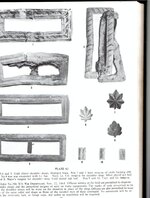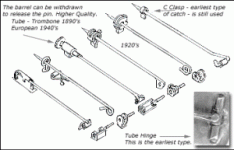BuckleBoy
Gold Member
Hello All,
I have always saved everything I've dug that might be something, or pieces that might be something if I could find enough pieces to ID. Well, over the years I've ID'ed a lot of finds that I dug a long time ago. Tonight I was sitting reading through the Crouch book on CW artifacts (Quindy left me a copy as a gift when he and Dman came here to hunt with us!). All of a sudden I saw something on the page that I recognized!
Back in 1995 or 96 I was digging an old resort in West Virginia that dated back to the 1820s and had some Yankee CW history. I was the first to dig the resort--it had never been hunted!--and the finds were incredible...but that's a story for another post. Anyhow, I dug lots of dropped minieballs and one carved bullet that day, plus some other great old relics, and two large cents, one of which was a nice Classic Head. Right in the middle of the CW dropped bullets I dug what I thought was a ladies' brooch from the 1920s. Looking at the style of pin back, which I thought was one of those types with the turning, "locking" mechanism I dismissed the find, tossed it in the box with some of the bullets and forgot about it for 12 years.
Well, when I saw the page in Crouch's book that deals with Lieutenant and Major insignia, I remembered the find, pulled it out of the box, and put it beside the photo in the book. Below the photo it says "Major's Oak Leaves."

So, are there any experts out there that can tell me if this find is CW era or much later? Here are some close-up photos of the pin back. (it was originally an iron pin, judging from the rust):




I cleaned the find with Aluminum Jelly and it looks even better...but what era is it from?
Before Aluminum Jelly:

After Aluminum Jelly:


Best Wishes,
Buckles
I have always saved everything I've dug that might be something, or pieces that might be something if I could find enough pieces to ID. Well, over the years I've ID'ed a lot of finds that I dug a long time ago. Tonight I was sitting reading through the Crouch book on CW artifacts (Quindy left me a copy as a gift when he and Dman came here to hunt with us!). All of a sudden I saw something on the page that I recognized!
Back in 1995 or 96 I was digging an old resort in West Virginia that dated back to the 1820s and had some Yankee CW history. I was the first to dig the resort--it had never been hunted!--and the finds were incredible...but that's a story for another post. Anyhow, I dug lots of dropped minieballs and one carved bullet that day, plus some other great old relics, and two large cents, one of which was a nice Classic Head. Right in the middle of the CW dropped bullets I dug what I thought was a ladies' brooch from the 1920s. Looking at the style of pin back, which I thought was one of those types with the turning, "locking" mechanism I dismissed the find, tossed it in the box with some of the bullets and forgot about it for 12 years.
Well, when I saw the page in Crouch's book that deals with Lieutenant and Major insignia, I remembered the find, pulled it out of the box, and put it beside the photo in the book. Below the photo it says "Major's Oak Leaves."

So, are there any experts out there that can tell me if this find is CW era or much later? Here are some close-up photos of the pin back. (it was originally an iron pin, judging from the rust):




I cleaned the find with Aluminum Jelly and it looks even better...but what era is it from?
Before Aluminum Jelly:

After Aluminum Jelly:


Best Wishes,
Buckles
Last edited:
Upvote
15









